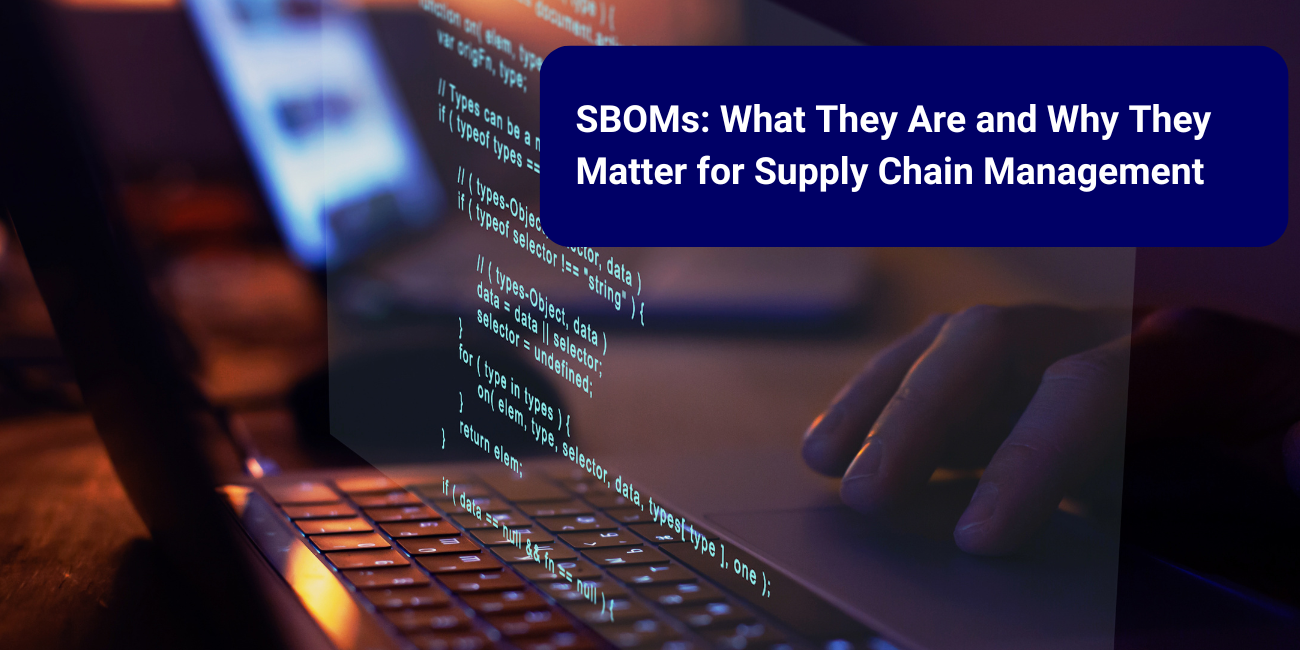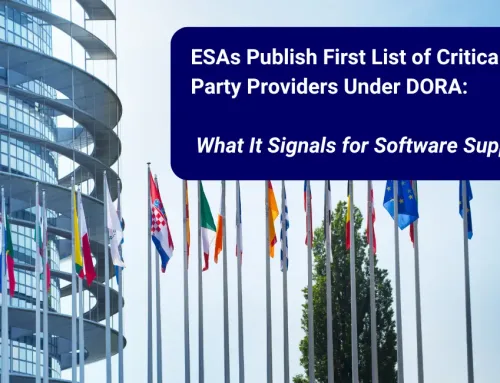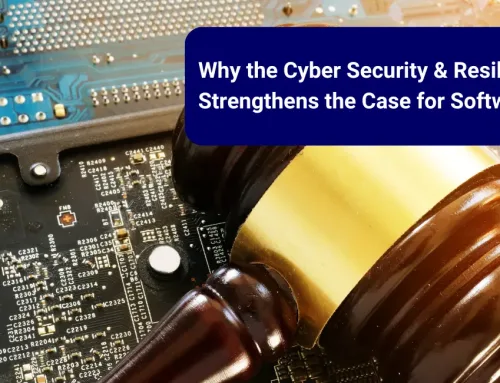SBOMs: What They Are and Why They Matter for Supply Chain Management
Software supply chain security has become a critical concern for organisations worldwide. From government mandates to enterprise procurement policies, companies are increasingly demanding detailed visibility into the components that make up their software. At the heart of this transparency movement lies the Software Bill of Materials (SBOM) – a document that’s rapidly becoming an essential companion to the software itself.
At The Escrow Company, we work closely with software vendors and end user companies who care deeply about both software integrity and business continuity. Over time, we’ve seen SBOMs transition from “nice-to-have” to often a contractual or audit requirement. This guide explains what SBOMs are, why they matter, and how they support modern software governance.
What is a SBOM?
A SBOM (Software Bill of Materials) is essentially a structured inventory of all the components, libraries, and dependencies that comprise a software application. Think of it as an “ingredients list” on a food package, but for software – it tells you exactly what’s inside.
A complete SBOM typically includes:
- Direct dependencies: Libraries and frameworks your application uses directly.
- Transitive dependencies: Libraries that those dependencies rely on – often the hidden parts of your supply chain.
- Version information: Exact version numbers for every component to enable precise vulnerability tracking.
- Licensing information: The license type and terms under which each component is distributed.
- Known vulnerabilities: Any publicly disclosed security issues linked to those specific component versions.
- Component metadata: Supplementary details such as supplier, source repository, and publisher information.
SBOMs are often machine-readable and follow standard formats, making them easy to integrate into tooling pipelines. Common formats include:
- SPDX (Software Package Data Exchange) – one of the most widely adopted formats
- CycloneDX – designed with supply chain / security use cases in mind
- JSON, XML, or other structured formats – allowing integration with existing software or security tools
Because SBOMs are structured, they can be consumed programmatically (for vulnerability scanning, compliance checks, etc.), rather than being only human-readable documents.
What are the use cases for SBOMs?
Here’s a deeper look at the main use cases and pressures driving widespread adoption of SBOMs today:
1. Supply Chain Security and Vulnerability Management
Much of modern software relies on third-party or open-source components. Vulnerabilities often lurk in those dependencies, code you didn’t write but still rely on.
A commonly known example is the Log4j “Log4Shell” vulnerability discovered in 2021, which silently affected millions of applications because many developers didn’t know (or weren’t tracking) their use of that library. An SBOM would immediately highlight the presence and version of Log4j, enabling faster risk identification and response.
With an SBOM, organisations can:
- Quickly identify whether they’re affected by newly disclosed vulnerabilities
- Understand the “blast radius” – which software parts depend on a vulnerable component
- Prioritise patching or mitigation based on actual usage
2. Compliance and Regulatory Requirements
Governments and regulatory bodies are increasingly mandating or recommending SBOMs as part of broader efforts to strengthen software supply chain security.
In the U.S., Executive Order 14028 (issued May 2021) first established the requirement for vendors to provide SBOMs for software delivered to federal agencies. Building on this, the Cybersecurity and Infrastructure Security Agency (CISA) released its 2025 Draft Guidance, “Minimum Elements for a Software Bill of Materials (SBOM),” for public comment in August 2025. The updated framework raises expectations by defining machine-readable formats, expanding mandatory data fields (including component hash, licence, tool name, and generation context), and extending coverage to SaaS and complex supply-chain use cases.
Across other regions, similar initiatives are taking shape:
- EU Cyber Resilience Act (CRA, 2022): Introduces mandatory SBOM requirements and greater transparency over third-party and open-source components.
- DORA (Digital Operational Resilience Act): Requires financial entities to track, as far as possible, their use of third-party and open-source libraries to strengthen ICT risk management.
- UK Government’s Software Security Code of Practice: Encourages organisations to understand the composition of their software and assess risks related to third-party components throughout the development lifecycle.
Together, these frameworks position SBOMs as a cornerstone of supply-chain integrity and transparency, providing visibility into component provenance and interdependencies.
In parallel, enterprise procurement policies are increasingly requiring SBOMs as part of vendor due diligence. They are also becoming a consideration in security certifications, audits, and cyber-insurance assessments.
Failure to provide or maintain an SBOM when required can put vendors at a competitive disadvantage – or even exclude them from certain contracts altogether.
3. Open-Source License Compliance
Open-source components come with license obligations (attribution, notices, share-alike clauses, etc.). SBOMs help organisations:
- Identify which licenses are in use across their software stack
- Ensure all obligations (attribution, license notices) are met
- Avoid inadvertent license violations (for example, mishandling GPL or copyleft dependencies)
- Demonstrate due diligence in legal or audit reviews
Because SBOMs bring transparency to the licensing profile of software, they reduce surprises and legal risk associated with using third-party code.
4. Risk Assessment, Due Diligence, and M&A Activity
When evaluating third-party software, procurement and security teams want to know exactly what they’re taking on. An SBOM helps them:
- Identify unmaintained or abandoned dependencies
- Gauge licensing risk exposure
- Assess component quality and security posture
- Understand vendor lock-in risk (especially when many internal modules rely on particular components)
This granular insight supports stronger decision-making during vendor selection.
SBOMs also play a key role in mergers, acquisitions, and lending scenarios, where software assets form a significant part of the transaction’s value. During due diligence, acquirers and lenders increasingly request an SBOM or independent third-party audit to:
- Verify the integrity and provenance of the software being acquired or financed
- Identify any embedded open-source or third-party code that could introduce legal or security liabilities
- Assess technical debt or hidden vulnerabilities that may impact valuation or post-acquisition risk
5. Incident Response and Forensics
In the event of a security incident, an SBOM can be a fast path to context:
- Which versions of which components were running?
- Could those versions be exploited?
- How widespread is exposure across your deployment portfolio?
Because SBOMs list exactly what is in your software, incident responders can quickly map vulnerability alerts to actual deployed instances and guide containment or remediation.
6. Software Maintenance and Long-Term Support
Particularly when:
- A vendor goes out of business
- The vendor ceases support
- A successor team must maintain the software
- Legacy systems must run long term
An SBOM – combined with source code, documentation, and build scripts which can be retrieved from a Software Escrow– ensures future maintainers or operators understand the full dependency graph. This is especially valuable in continuity situations, where the beneficiary needs to take over or replicate software operations.
Are SBOMs ever mandatory?
SBOMs are becoming mandatory or expected in many contexts:
- Government contracts – many agencies now demand SBOMs from software vendors
- Enterprise procurement – large organisations routinely require vendors to provide SBOMs prior to contracting
- Cloud platform ecosystems – certain platforms (AWS, Azure, GCP) or marketplace policies may request SBOM metadata
- Security certifications / audits – SBOMs may be evaluated as evidence of supply chain transparency
- Insurance / liability policies – some policies may reference SBOM as part of risk controls
- Software escrow and continuity agreements – increasingly, beneficiaries insist on SBOMs as part of software audits and governance
Because SBOM demands vary by sector and geography, vendors should prepare for them proactively in contracts, development pipelines, and audit processes.
Best Practices for SBOM Implementation
To get full value from SBOMs, software teams should follow these principles:
- Keep SBOMs current – update whenever dependencies change or new modules are added
- Automate the process – integrate SBOM generation into your CI/CD or build pipelines
- Include transitive dependencies – indirect libraries matter just as much as direct ones
- Specify and document the format – declare whether you are using SPDX, CycloneDX, or another standard
- Version your SBOMs – track SBOMs in tandem with software versioning
- Make SBOMs accessible – provide to customers, regulators, or internal security teams (with appropriate controls)
- Validate and audit SBOM contents -ensure the SBOM accurately reflects the codebase (no omissions or mismatches)
These practices help ensure SBOMs remain trustworthy, useful, and credible.
SBOM and Software Escrow: The Connection
While software escrow and SBOMs serve separate and distinct purposes, they complement one another in a robust supply chain governance and business continuity framework. Where the use of third-party systems provides greater agility, speed to market or functionality governing that is critical to the security and long term availability of the solution:
- Software escrow facilitates business continuity – it involves depositing source code, documentation, deployment scripts, and other materials with a trusted third party so that if a vendor fails, the beneficiary can access and operate the software.
- SBOMs provide transparency into what the software is built from – giving insight into component provenance, licensing, and security posture.
Increasingly, beneficiaries and enterprise clients request both:
- They want an SBOM so they can assess the internal risks and dependencies of third-party software whilst using and to understand the posture should they ever need to obtain or run the product following a supplier failure event.
- They want software escrow so they can assume control, access key assets like source code or maintain operations if the vendor becomes unavailable.
Vendors who can offer both SBOMs and software escrow-backed continuity gain a stronger competitive position when selling business critical services, or high-risk and highly regulated markets.
At The Escrow Company, our Open-Source Code Audit services include SBOM generation and analysis. This means every audit gives insight into the security of the software in its current state and any licence requirements should it be released to them in an escrow triggering event.
Our final audit report provides a complete overview of the Build of Materials including:
- An inventory of all source code files contained within the codebase
- List of files containing copyrights
- List of files containing licenses
- List of open-source licenses linked to this code
- Detailed report authored by an open-source licensing expert identifying possible constraints, potential IP issues, and known security vulnerabilities with the audited open-source code.
To request an open-source code audit including an SBOM, or discuss how this would combine with a Software Escrow agreement, contact the Escrow Company’s expert team.
Frequently Asked Questions About SBOMS
SBOM stands for Software Bill of Materials. It’s a detailed, often machine-readable inventory of all components, dependencies, and metadata that go into building a software application..
Not exactly. A simple dependency list may name packages and versions; an SBOM goes further - it typically includes licensing details, supply chain provenance, component checksums, vulnerability metadata, and format-specific structure.
Any parties: U.S. federal agencies (under EO 14028) enterprises for vendor risk assessment, cloud platforms, compliance auditors, and security teams. SBOMs are rapidly becoming a standard expectation in contracts, particularly in regulated industry verticals.
Whenever your software changes - especially when dependencies are added, removed, or upgraded. In practice, this often means regenerating your SBOM with every release or build cycle.
SBOMs and escrow serve different but complementary roles: SBOMs provide insight into software composition and risks, while software escrow facilitates continuity if a vendor fails. Together, they help organisations manage both security and business resilience.
Yes - though it depends on risk appetite and stakeholder agreements. Public SBOMs promote transparency and community scanning, but can also help attackers identify vulnerable versions. Many organisations share SBOMs selectively (e.g. under NDA) or publish sanitized versions.








